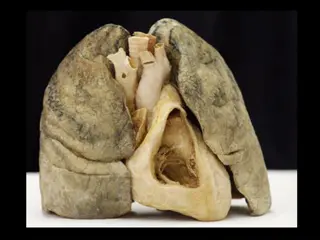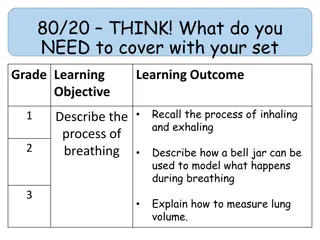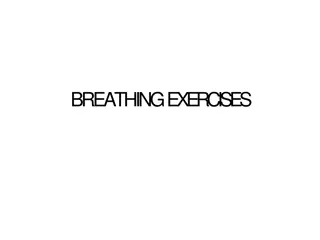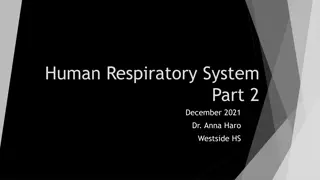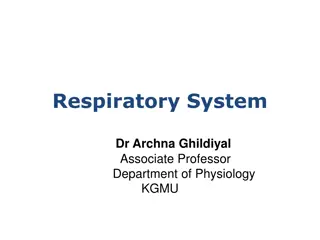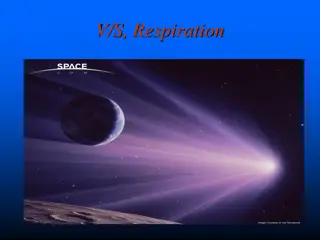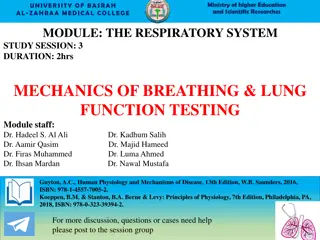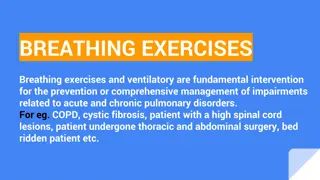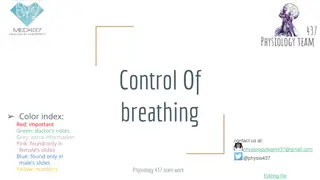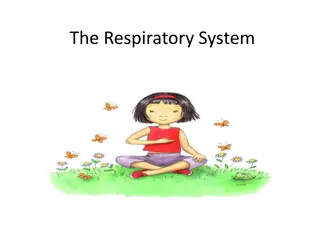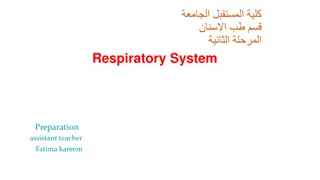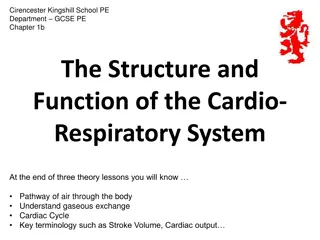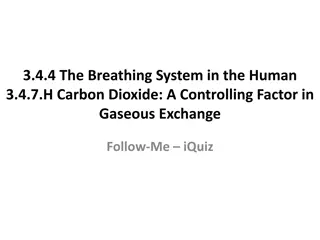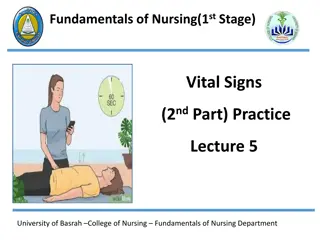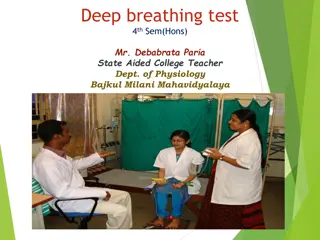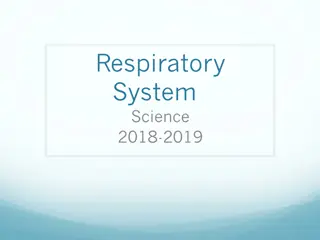Understanding the Importance of Breathing and Respiratory System
Breathing plays a crucial role in delivering oxygen to the body and removing carbon dioxide. The respiratory system, including the lungs, trachea, bronchi, and alveoli, functions to facilitate this vital process. The diaphragm muscle helps in inhaling and exhaling, while the exchange of oxygen and carbon dioxide occurs in the alveoli. Learn about the intricate mechanisms of respiration and how oxygen is transported to body tissues for energy production.
Download Presentation

Please find below an Image/Link to download the presentation.
The content on the website is provided AS IS for your information and personal use only. It may not be sold, licensed, or shared on other websites without obtaining consent from the author. Download presentation by click this link. If you encounter any issues during the download, it is possible that the publisher has removed the file from their server.
E N D
Presentation Transcript
The goal of breathing is to deliver oxygen to the body and to take away carbon dioxide. The lungs are the main organs. The red blood cells are responsible for picking up the oxygen in the lungs and carrying the oxygen to all the body cells that need it. The trachea (TRAY-kee-uh} is sometimes called the windpipe. The trachea filters the air we breathe and branches into the bronchi. The bronchi (BRAHN-ky) are two air tubes that branch off of the trachea and carry air directly into the lungs. Alveoli: Bronchiolies eventually lead to tiny, stretchy sacs called alveoli. These sacs blow up like tiny balloons when you breathe in. Oxygen from the air passes through the walls of the alveoli into capillaries while carbon dioxide is passed out.
Diaphragm Breathing starts with a dome- shaped muscle at the bottom of the lungs called the diaphragm (DY-uh- fram). When you breathe in, the diaphragm contracts. When it contracts it flattens out and pulls downward. This movement enlarges the space that the lungs are in. This larger space pulls air into the lungs. When you breathe out, the diaphragm expands reducing the amount of space for the lungs and forcing air out. The diaphragm is the main muscle used in breathing.
Carbon dioxide is the waste gas that is produced when carbon is combined with oxygen as part of the body's energy-making processes. Respiration is the term for the exchange of oxygen from the environment for carbon dioxide from the body's cells. The process of taking air into the lungs is called inhalation or inspiration, and the process of breathing it out is called exhalation or expiration. The lungs differ in size and shape. Because the heart is slightly larger on the left side, the left lung has a cardiac notch (indented border). The left lung is also slightly smaller than the right. Each lung is divided into lobes (partitions) by fissures. The right lung has three lobes: lower, middle, and upper. These horizontal and oblique fissures create these lobes. The left lung has upper and lower lobes that are divided by the oblique fissure. Air enters the body through the mouth or nose. In the nose, thick hairs lining the nostrils prevent small objects from entering the nasal cavity. This cavity is lined with cells that produce mucus. Small foreign matter that enters the nasal cavities is trapped in the mucus, while tiny cilia (small hair-like projections) push the mucus to the pharynx (throat), where it is swallowed and digested in the stomach or expectorated.
With each inhalation, air fills a large portion of the millions of alveoli. In a process called diffusion (pronounced: dih-fyoo-zhun), oxygen moves from the alveoli to the blood through the capillaries (tiny blood vessels, pronounced: kah-puh-ler-eez) that line the alveolar walls. Once in the bloodstream, oxygen gets picked up by a molecule called hemoglobin (pronounced: hee-muh- glo-bun) in the red blood cells. This oxygen-rich blood then flows back to the heart, which pumps it through the arteries to oxygen-hungry tissues throughout the body.
Fun quizzes to practice with http://www.neok12.com/quiz/RESSY01 http://www.neok12.com/quiz/RESSY03 http://www.neok12.com/quiz/RESSY04
Things That Can Go Wrong With the Lungs and Respiratory System: genetics, pollutants and irritants, and infectious diseases can affect the health of your lungs and respiratory system and cause respiratory problems. Problems during their teen years include: Asthma. (pronounced: az-muh) Over 20 million people in U. S. is a long-term, inflammatory lung disease that causes airways to tighten and narrow when a person with the condition comes into contact with irritants such as cigarette smoke, dust, or pet dander. Bronchitis:doesn't affect most teens, it can affect those who smoke. In bronchitis, the membranes lining the larger bronchial tubes become inflamed and an excessive amount of mucus is produced. The person with bronchitis develops a bad cough to get rid of the mucus. Common cold:caused by over 200 different viruses that cause inflammation in the upper respiratory tract. The common cold is the most common respiratory infection. Cystic fibrosis (CF). CF is an inherited disease affecting the lungs. CF causes mucus in the body to be abnormally thick and sticky. The mucus can clog the airways in the lungs and make a person more likely to get bacterial infections. Pneumonia. Pneumonia is an inflammation of the lungs, which usually occurs because of infection with a bacteria or virus. (Streptococcus pneumoniae)
Why Do I Yawn? When you are sleepy or drowsy the lungs do not take enough oxygen from the air. This causes a shortage of oxygen in our bodies. The brain senses this shortage of oxygen and sends a message that causes you to take a deep long breath---a YAWN. Why Do I Sneeze? Sneezing is like a cough in the upper breathing passages. It is the body's way of removing an irritant from the sensitive mucous membranes of the nose. Many things can irritate the mucous membranes. Dust, pollen, pepper or even a cold blast of air are just some of the many things that may cause you to sneeze. What Causes Hiccups? Hiccups are the sudden movements of the diaphragm. It is involuntary --- you have no control over hiccups, as you well know. There are many causes of hiccups. The diaphragm may get irritated, you may have eaten to fast, or maybe some substance in the blood could even have brought on the hiccups.
1. Exchange of air occurs in _______ which are also known as 'air sacs'. A. Alveoli B. Alveolar ducts C. Bronchi D. Bronchioles Answer: 2. Identify bronchus in this diagram. Answer: 3. Write the correct sequence of the pathway through which air travels after entering the body. A. Larynx, pharynx, trachea bronchioles B. Pharynx, larynx, trachea, bronchioles C. Pharynx, larynx, bronchioles, trachea D. Pharynx, trachea, larynx, bronchioles
4. Which process does not occur in the nasal cavity? A. Trapping of large foreign bodies B. Exchange of gases C. Humidification of inhaled air D. Warming of inhaled air Answer: 5. Normal rate of respiration in an adult human being is _______ times/ minute. A. 10-12 B. 12-14 C. 16-18 D. 22-24 Answer: 6. Spirometer measures: A. Capacity of lungs B. Volume of air inhaled and exhaled C. Residual air D. All of these Answer:
7. Identify diaphragm in this diagram. B C D E Answer: 8. Complete the equation: Glucose + Oxygen = _______ + Water + CO2 A. Sucrose B. Starch C. Energy D. None of these Answer:
9. What is the leaf-like structure (#1) which prevents the entry of food into respiratory passages? A. Larynx B. Epiglottis C. Pharynx D. Tongue Answer: 10. Which part of the respiratory tract is also known as the voice box? A. Pharynx B. Trachea C. Larynx D. Epiglottis Answer: 11. Which cells of the blood carry oxygen to different parts of the body? Answer: 12. True or False: Trachea contains 16-20 'C'-shaped cartilaginous rings. True False Answer:
13. True or False: Breathing through the mouth is considered as good as breathing through the nose. True False Answer: 14. True or False: Exhalation and inhalation of air is known as "cellular respiration". True False Answer: 15. True or False: Two-layered membrane which covers the lungs is known as pericardium. True False Answer:


